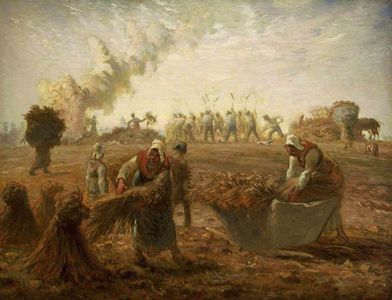Fagopyrum esculentum
Fagopyrum esculentum Moench
| Ordre | Caryophyllales |
|---|---|
| Famille | Polygonaceae |
| Genre | Fagopyrum |
2n = 16, 32
Origine : nord-ouest du Yunnan (Chine)
sauvage ou cultivé
| Français | sarrasin |
|---|---|
| Anglais | buckwheat |
- fruits consommés comme pseudo-céréale
- légume-feuille
- fourrage
- médicinal
- colorant bleu extrait des pailles
Sommaire
Description
Noms populaires
| français | sarrasin, blé noir |
| anglais | buckwheat |
| allemand | Buchweizen |
| néerlandais | boekweit |
| italien | grano saraceno |
| espagnol | trigo sarraceno, alforfón |
| portugais | sarraceno, trigo mourisco |
| polonais | gryka |
| russe | гречиха - grečiha, гречка - grečka |
| chinois | 荞麦 - qiao mai (Flora of China) |
| japonais | soba |
| Thaïlande | phakbung-som (nord) (PROSEA) |
| Vietnam | mạch ba góc, mạch hoa (PROSEA) |
| Laos | khauz sa:m hlièmx (PROSEA) |
- Voir les noms de la Flore populaire d'Eugène Rolland
Classification
Fagopyrum esculentum Moench (1794)
basionyme :
- Polygonum fagopyrum L. (1753)
synonymes :
- Fagopyrum vulgare Hill (1756), nom. illeg.
- Fagopyrum emarginatum (Roth) Moench (1802)
subsp. esculentum
formes cultivées
subsp. ancestrale
- subsp. ancestrale Ohnishi (1998)
formes sauvages
Cultivars
Histoire
Usages
The cultivated races. Cultivated in Tibet, Himalaya area, India, Russia, China, Korea, Japan, Central and W Europe, but also, more recently, in Canada, USA and Cuba. Common buckwheat is used as a vegetable, as animal feed, as a green manure and as a source for buckwheat honey. But most important for human consumption are the grains, used cooked like rice or as flour for the preparation of pancakes, biscuits, noodles. In eastern Europe it is used for porridge and soups, in SE Asia an unleavened bread is made from the flour. In Russia, where it is an important crop even today, it was not grown to a larger extent until the 15th cent. In central and western Europe it is now a declining crop. In Canada and the USA an increase of the growing area can be observed. Buckwheat is known to have been cultivated in China as early as the 2nd/1st cent. BC. Other sources date the cultivation back to earlier times. It is believed to have been introduced into Japan already about 3.000 years ago, via the Korean peninsula. It is known in Central Europe since the 13th cent. probably introduced via E Europe. The centre of origin is obviously in southern China, where several other Fagopyrum species occur (F. homotropicum Ohnish in Fagopyrum 15 (1998); F. statice Gross; F. urophyllum (Bur. & Franch.) Gross; F. leptopodum (Diels) Hedb.; F. lineare (Sam.) Haralds. Most recently new species closely related to cultivated buckwheat have been described from Sichuan (F. megaspartamium Q.-F. Chen in Bot. J. Linn. Soc. 130 (1999) 62) and Tibet (F. zuogangense Q.-F. Chen, l.c. and F. pilus Q.-F. Chen, l.c.). Some of them may have been involved in the evolution of F. esculentum; but the true wild progenitor is F. esculentum subsp. ancestrale from the north-west corner of Yunnan province. Fagopyrism may occur in animals with light skin after feeding larger amounts of buckwheat. Fagopyrin sensibilizes the skin to light. Also observed in humans after consumption of honey from buckwheat. Buckwheat is a rather variable crop. The most important morphological races are var. esculentum, mainly cultivated in Europe and the New World and var. emarginatum (Roth) Alef. (Landw. Fl., 1866, 286) mainly cultivated in the eastern part of the cultivation area (China, Japan, India), for the infraspecific variation compare also Krotov (1975). Occasionally natural crosses have been occured between this and the following species. The hybrids are amphidiploid and have been described as Fagopyrum giganteum Krotov (in Kul't. Fl. SSSR 3, 1975, 16).
Références
- Chauvet, Michel, 2018. Encyclopédie des plantes alimentaires. Paris, Belin. 880 p. (p. 565)
- Campbell, Clayton G., 1997. Buckwheat. Fagopyrum esculentum Moench. Promoting the conservation and use of underutilized and neglected crops, 19. Gatersleben, Institute of Plant Genetics and Crop Plant Research / Rome, International Plant Genetic Resources Institute. 93 p. télécharger sur Bioversity
- Dambourney, Louis-Alexandre, 1786. Recueil de procédés et d'expériences sur les teintures solides que nos végétaux indigènes communiquent aux laines & aux lainages. Paris, De l'imprimerie de Ph.-D. Pierres, premier imprimeur ordinaire du roi. 407 p. Voir sur Pl@ntUse
- Ohnishi, O., 1998. Search for the wild ancestor of buckwheat III. The wild ancestor of cultivated common buckwheat, and of Tatary buckwheat. Econ. Bot., 52: 123-133. doi: 10.1007/BF02861199
- Schilperoord, Peer, 2017. Plantes cultivées en Suisse – Le sarrasin. 29 p. doi : 10.22014/97839524176-e8.
- Version allemande : Kulturpflanzen in der Schweiz – Buchweizen. doi : 10.22014/97839524176-e7.
Liens
- BHL
- FAO Ecocrop
- Feedipedia
- Flora of China
- Grieve's herbal
- GRIN
- IPNI
- Mansfeld
- Moerman, Native American Ethnobotany
- Multilingual Plant Name Database
- NewCrop Purdue
- Plant List
- Plants for a future
- Plants of the World Online
- PROSEA sur Pl@ntUse
- PROTA sur Pl@ntUse
- TAXREF
- Tela Botanica
- Useful Tropical Plants Database
- Wikipédia
- Wikiphyto
- World Flora Online









